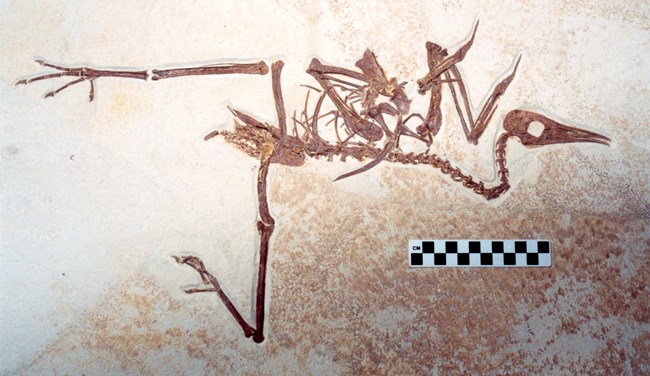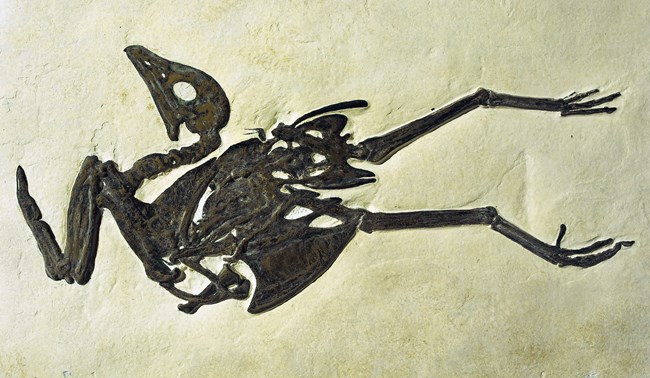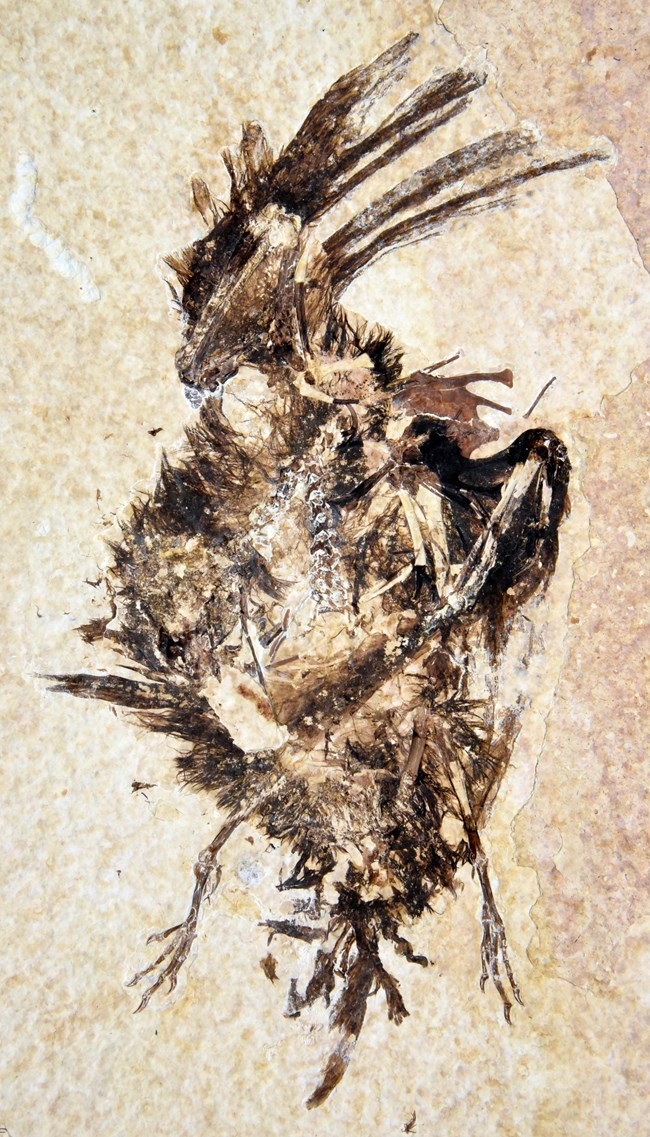|
Over 30 species of birds, belonging to more than 20 families, have been identified from the Fossil Butte Member (FBM). The bird fossils include:
See what fossil birds (52-million years old) are on display in our visitor center exhibits. 
NPS Photo Shoreline Bird - Pseudocrypturus cercanaxiusOrder Lithornithiformes, Family LithornithidaeP. cercanaxius had long legs and a long, narrow beak. It was likely a wading bird that inhabited the shoreline of Fossil Lake, using its long beak to search for insects and other invertebrates. The wing and foot structure suggest that, unlike its living relatives in the superorder Paleognathae, P. cercanaxius was capable of sustained flight and perching. 
NPS Photo Land Fowl - Gallinuloides wyomingesisOrder Galliformes, Family GallinuloidadeThe Galliformes order has over 200 living species, divided into 8 families. Most of these species are ground-feeding herbivores including pheasants, turkeys, chickens, and quails. These species are capable of flight, but are commonly known to run in the escape of a predator. G. wyomingesis is the oldest known species of the Galliformes order. It was also the first bird species discovered in the FBM. G. wyomingesis is considered a non-aquatic bird, but it has been found in both near-shore and mid-lake deposits. This indicates that G. wyomingesis may have attempted to fly over Fossil Lake on occasion. 
NPS Photo Early Roller - Primobucco mcgrewiOrder Coraciiformes, Family PrimobucconidaeModern members of the Coraciiformes include "true" roller birds. Modern rollers are characterized by large heads and short legs. They are strong fliers. They are insectivores, typically catching and eating insects while in flight. Modern rollers are found in the tropical and warm temperate regions of Africa, Europe, Asia, and Australia. P. mcgrewi is the only species in the Primobucconidae family, and is considered a stem roller. It may have been more omnivorous than modern rollers. P. mcgrewi is one of the most common bird species found from Fossil Lake. Parrots - 4 Species Identified: Cyrilavis colburnorum & Cyrilavis olsoni & Avolatavis tenens & Tynskya eocaenaOrder Prittaciformes
The FBM contains the earliest, well-preserved fossil parrots in the world. FBM parrots lack the modern parrots' characteristic beak, suggesting their diet was less specialized. Frogmouths, Swifts, and Oilbirds - 2 species identified: Fluvioviridavis platyrhamphus and Prefica niveaOrder Caprimulgiformes
Fluviorviridavidae contains 13 living species found in tropical and subtropical regions on Asia, India, and Australia. Frogmouths are so called because of their large, flat bills. They catch insects and small vertebrates. They are nocturnal. The FBM species, F. platyrhamphus, is the earliest known species of frogmouth. It has only been found in nearshore quarries. There is at least one currently undescribed species that likely belongs to the extinct family Eocypselidae. This family seems to be closely related to the modern swift family Apodidae but also possibly to the hummingbird family Trochilidae. Most fossils are from midlake quarries. The family Steatornithidae contains only two birds: the extinct P. nivea and the living Steatornis caripensis. S.caripensis is found in tropical and subtropical regions of northern South America, Central America, and the island of Trinidad. Its diet consists of mostly palm fruits. It is the only herbivorous bird in the order caprimulgiformes. S.caripensis nests in caves and uses echolocation to navigate, much like bats. 
NPS/Arvid Aase New undescribed species of birdResourcesGrande, Lance. 2013. The Lost World of Fossil Lake: Snapshots from Deep Time. Chicago: The University of Chicago Press. |
Last updated: September 26, 2025
